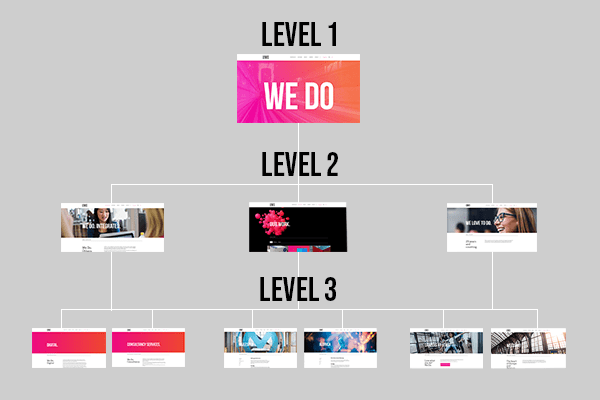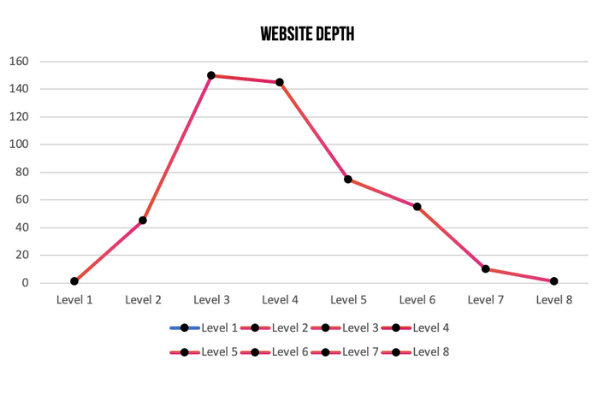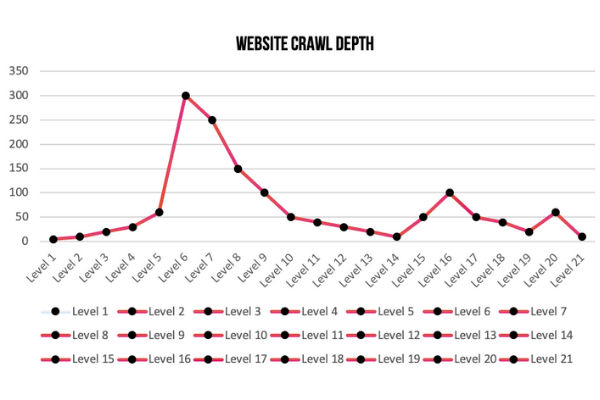Key Takeaway
The most important URLs should be included as high up in a site’s architecture as possible.
What is Site Depth?
Site depth refers to the level search engines crawl and index pages within the site. The further down the URL sits within the site, the more difficult it is for bots to reach and frequently crawl. Therefore, these pages are deemed less important and harder to rank in SERPs.
What is Click Depth?
The level of a page within a site refers to how deep it sits inside the site’s architecture. The depth of a page is denoted by the number of levels inside the site, and these levels are determined by the clicks users have to take starting from the home page. The more clicks it takes to navigate to a page the deeper the level. In this example the homepage URL would be considered the start level, pages that are linked from it would be considered level two, and pages linked to level two pages would be on level three.

Why is Click Depth Important?
Click depth is imperative for SEO because it affects search engines for both crawling and indexing URLs. Search engines take a lot of signals from the way a website is architected, and website content is grouped. Internal link depth affects search engines capabilities to maneuver a website and discover pages to add to its index. It also assists in establishing the significance and topical themes of landing pages, which is influential for keyword rankings in SERPs.
Great Site Depth
A good rule of thumb is to have a robust number of pages within three clicks from the homepage in comparison to the entire number of pages. These pages should be the most critical to the brand and prioritized to align with businesses goals and interests of the target audience. The more prominent and higher level (2, 3, 4) a page sits within the site’s architecture, the more search engines notice and easier it is for them to crawl. A best in class example below showcases the majority of pages are within three clicks for users to navigate to. The highest number of pages are found on level three, with the deepest web crawl level of eight. Pages that fall between level four and level eight are pages that are considered less important to the brand.

Poor Site Depth
An example of a website that has an unhealthy number of pages that fall outside three clicks from the homepage relative to the total amount of pages. There are critical pages that are less prominent and site on a lower level (5,6,7, etc.) of the site’s architecture. An example of a poor crawl depth distribution can be seen below. The bulk of the site’s primary pages take more than three clicks for users. The highest number of pages are found on level six with the deepest web crawl level of sixteen. There are core pages that can be found on level twelve and twenty-two. Important pages that take more than three clicks to reach, should be evaluated on whether or not they need to be moved higher up in the site structure.

What Is The Relationship Of Click Depth to Pagerank?
Click depth significantly impacts PageRank, Google’s system for ranking web pages. Pages requiring fewer clicks from the homepage generally have higher PageRank, as they’re more accessible and likely to receive inbound links. Conversely, pages buried deeper in a site’s structure (more clicks away) typically have lower PageRank, being less visible to search engines and users. Thus, reducing click depth can enhance a page’s PageRank and visibility in search results.
How to Improve Click Depth?
Utilize internal linking to lower the depth of a page. This can be done by linking a page that sits higher up in the site’s architecture to the lower level page. This is the most effective solution to combat sites with deep page issues method that requires the least amount of effort. Furthermore, adding breadcrumbs to the site if it does not already would help users and search engines alike to navigate deeper seeded pages. If the site has serious click depth issues, an alternative method would be to restructure and overhaul the entire site. The first two solutions should be tried first since this option can be an extremely costly and resource intensive, especially if the site is large.
How to Measure Success?
So how can you see the fruits of your labor of moving or altering the depth level of a page? This can be achieved by benchmarking data and monitoring the following metrics. These metrics are found in Google Analytics and Moz for the targeted page.
- Page Authority: A Moz metric, that predicts the likelihood that a single page will rank well, regardless of its content. The higher the PA score the more likely the individual page will rank well.
- Keyword Rankings: The position of keywords that search engines associate with a corresponding page.
- Organic Traffic: Visitors entering the page from search engine results.
- Pages per session: The number of pages a user views per visit to your site.
- Frequency: How often people visit the site. If users are continuously coming back to the page, it is considered valuable and easy to navigate to.
Need advice from our SEO experts? Reach out today!



